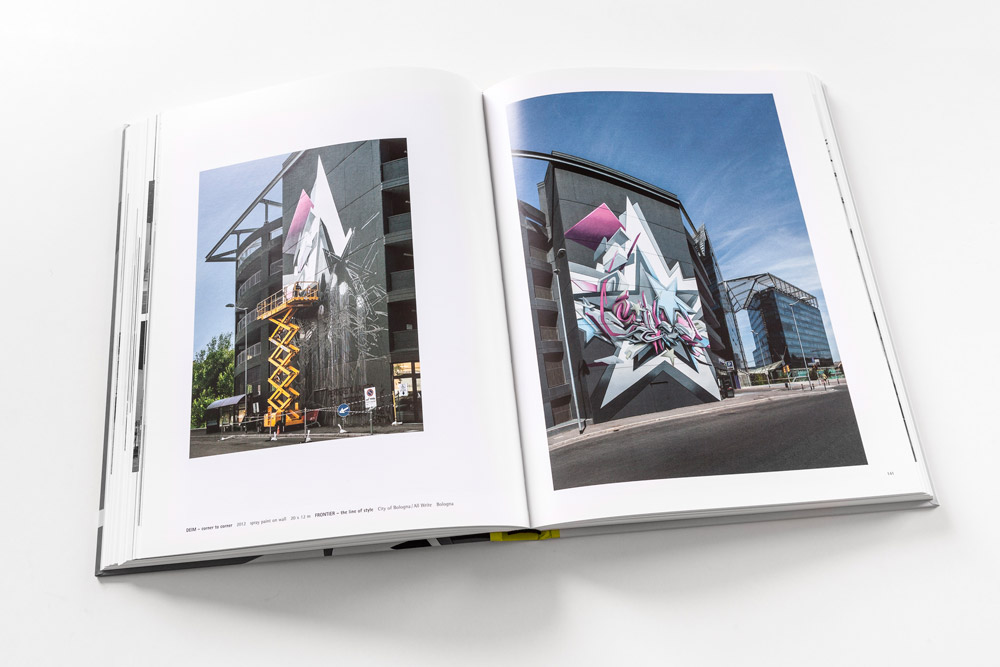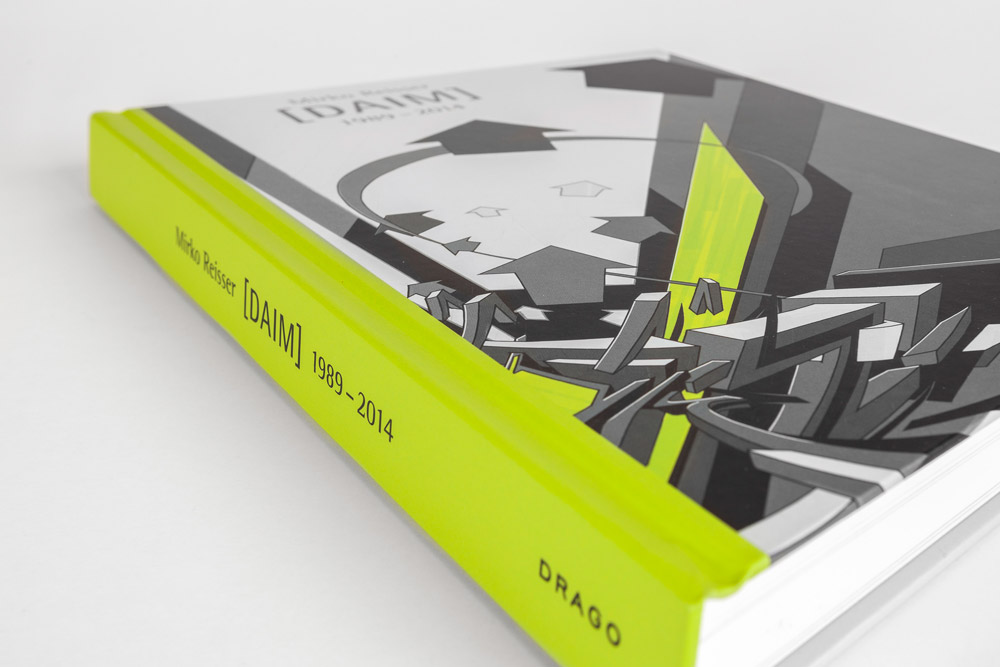An Interview with graffiti artist Mirko Reisser (DAIM) by Arne Rautenberg
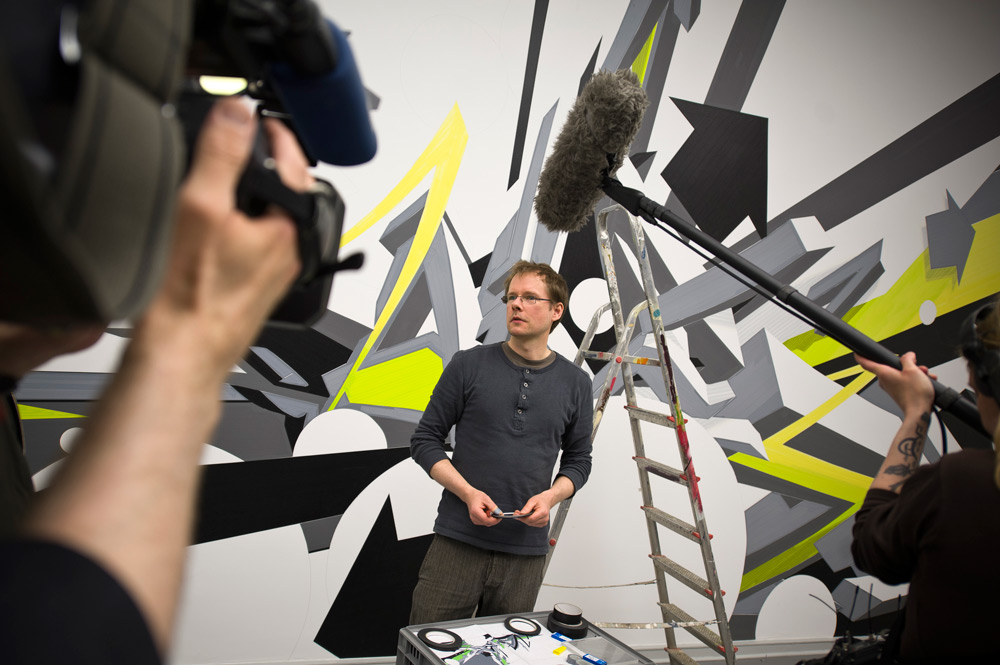
Mirko Reisser (DAIM), “DAIM – up and around”, taping on wall, Exibition: “Street-Art – meanwhile in deepest east anglia thunderbirds were go…” | Von der Heydt Kunsthalle Barmen, Wuppertal / Germany | 2011 | making of | Courtesy: von der Heydt-Museum / REINKINGPROJEKTE | Photo: Boris Niehaus (JUST) [CC-BY-SA-3.0] — Courtesy: von der Heydt-Museum / REINKINGPROJEKTE | Photo: Boris Niehaus (JUST)
Daim: The content is very clearly linked to the form. These are my letters. This is my name. This is my work. Of course, I don’t give fresh thought to what I want to write each time I produce a piece. I’m very glad that I have this basis and can concentrate on the spatial context in which the work is to be presented or on the respective style, which indeed functions according to an emotion that simply has to feel right.

Mirko Reisser (DAIM), “DAIM – up and around”, taping on wall, 1050 x 405 cm, 2011 | part | Exibition: “Street-Art – meanwhile in deepest east anglia thunderbirds were go…” | Von der Heydt Kunsthalle Barmen, Wuppertal / Germany | 2011 — Courtesy: von-der-Heydt Museum / REINKINGPROJEKTE | Photo: MRpro
And you do still have the feeling that the name DAIM signifies you, even after working with it for twentyfive years?
Daim: Absolutely. And my use of the name DAIM is becoming more and more complex. I perceive it as a kind of self-portrait—my entire personality has impact on the works. My development as a human being strongly corresponds to my development as an artist. This is a process that has something to do with personal maturing, the general situation of aging. On the one hand, I have become quite versed in the procedures of production. On the other hand, the desire increases to understand what one is actually up to. In this manner, one can learn something about oneself as a human being and a personality. In a certain way, it is a privilege to be able to focus so strongly on oneself. It’s a real opportunity. Indeed, everyone should receive this opportunity.
One becomes more aware of oneself and can draw one’s self-understanding from this to a certain extent.
Exactly. For this reason, graffiti and the various facets that emerged from it were able to evolve. Because it was, and still is, the product of a youth culture. The search for the self and the development of an autonomous self-awareness are elemental components of graffiti culture.
In the meantime, some of your colleagues also present their works in galleries. How willing is the scene to accept the art space as a field of work? Ordinarily, this also entails giving up one’s undercover status and, conversely, incorporating commercial aspects in the work.
Of course it is always difficult to speak for the scene. But if one has a look at how the graffiti movement developed toward the end of the 1960ies and the beginning of the 70ies, particularly in New York, then one can say: it took place in the public space, on the subways, and thus for sure also to a certain degree in an illegal sphere. Yet at that time there did not yet exist a sense of doing something illegal. Graffiti was practiced for other reasons, induced by an inner necessity. The aspect of illegality did not play the decisive role. And already at a very early stage, at the beginning of the 80ies, the art market became engaged with parts of the graffiti scene. In fact, artists such as Jean-Michel Basquiat or Keith Haring also became successful emerging from this scene. But also traditional graffiti sprayers who came from the subway scene as, for instance, DONDI, LEE, DAZE, CRASH, or SEEN toured the world with their works. Their works were also shown in European museums and thus found their way into important collections of art. However, a permanent establishment of the young sprayers on the art market only worked to a limited extent. Perhaps not all aesthetic positions or personalities were already mature enough.
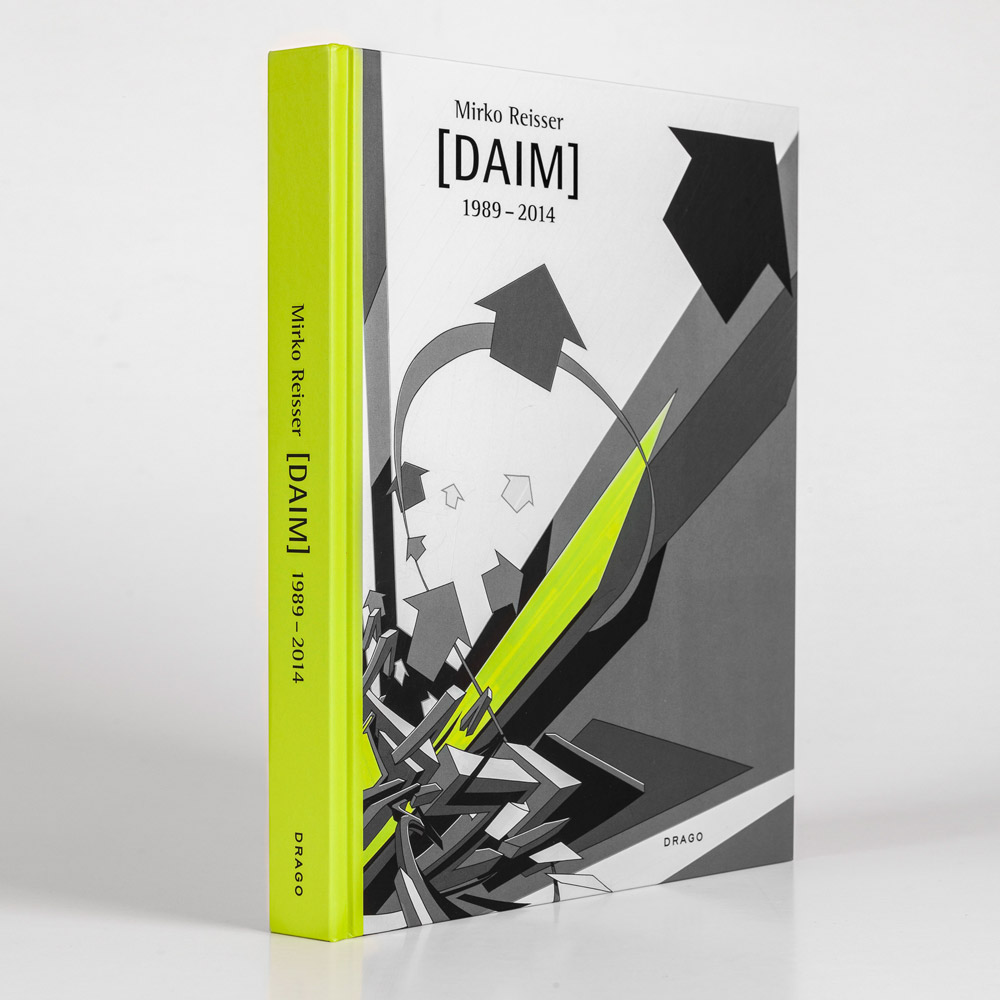
Mirko Reisser (DAIM) 1989 – 2014 – Click To Purchase
Graffiti was thus still an open format, which offered space for many possibilities?
Daim: At that time both illegal spraying in the public sphere and working on canvas were tightly interwoven for me. The whole atmosphere in the scene was open. One could become involved in any chosen aspect of it. It wasn’t exactly the case that an illegal subway graffiti scene happened to come to Europe and everybody was saying: this is the way you’re supposed to do it. The dogmatism that it received later through the local hip-hop scene is actually something that is more typically German. In America nobody really felt the urge to go to those kinds of extremes. There was no necessity at all to connect everything in such a rigid manner.
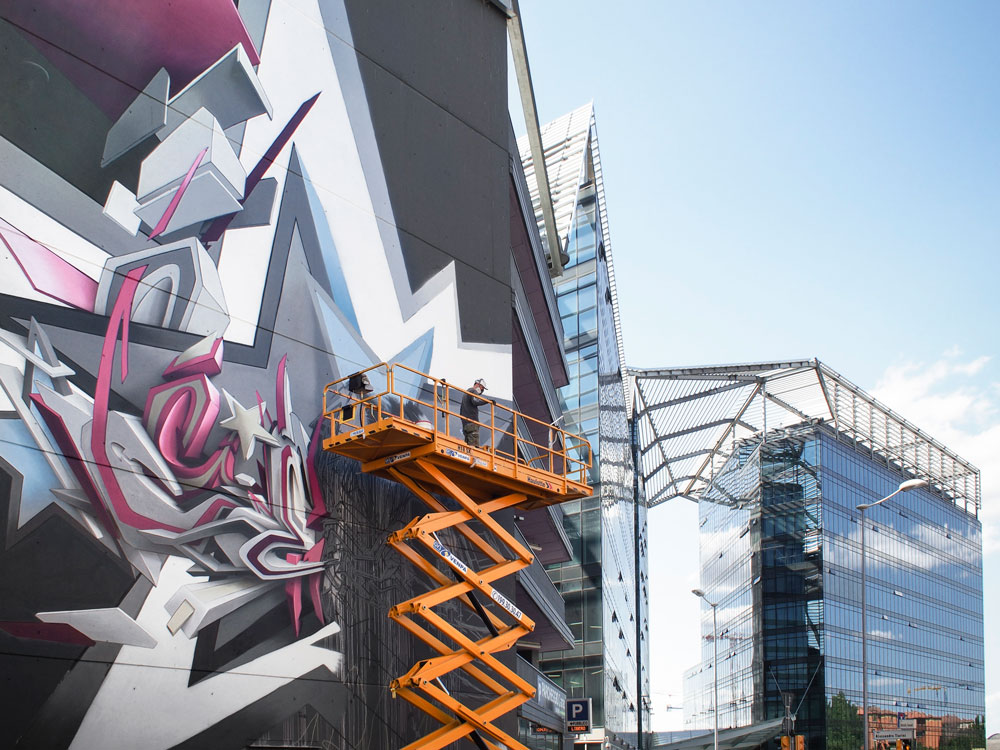
Mirko Reisser (DAIM) | “DEIM – corner to corner” | 20 x 12 m | Bologna, Italy | 2012 | For “Frontier – the line of style” / Comune de Bologna and Associazione Culturale ALL WRITE | making of — Courtesy: Associazione Culturale ALL WRITE / Frontier | Photo: Marco Monetti
How did things proceed for you from that point onward?
Daim: In 1987/88, many illegal sprayers in Hamburg were apprehended. There was a gigantic void. The graffiti scene was more or less dead here. My spraying career began around that time. After all, I was already seventeen. So I was able to approach the subject with a slightly broader horizon than a twelve- or thirteen-year-old. My work could thus develop in a more open form and also more freely. From the very beginning, I also worked on canvas. Already in 1991, I participated in an contest as part of an exhibition at the Altonaer Museum in Hamburg. This museum was one of the first in Germany that kept track of the phenomenon of graffiti and dedicated a large exhibition to it. However, although I was working on canvas and also started participating in exhibitions rather swiftly, I also needed the illegal adventure. In 1991, I wrote the signature DAIM for the first time.
The years 1992 and 1993 were the decisive years in which I then fully concentrated on developing my new style. It became increasingly more three-dimensional, and I was able to realize it together with my collaborators of the time like Hesh, or celebrities of the scene such as Loomit, in many large wall productions. Resultantly, I eventually became relatively widely known in the scene.
In principle everything was possible. And there was also a high amount of acceptance for these possibilities. Of course, in the scene as such this was sometimes also connected to discussions about what was and what was not permissible. To a certain extent, dogmatism belongs to this as well. Scenes cannot really exist without distinctions. A certain framework is needed. And I accepted this framework. Yet I always had awareness for wanting to go beyond the constraints of this framework as well.
You then went to Switzerland, again to study fine arts. What compelled you to take this step?
Daim: After seven years of being engaged in the graffiti scene I felt I really needed to see the bigger picture. Pius Portmann introduced me to the Lucerne University for Applied Sciences and Arts, where I studied fine arts. In the course of the years that I spent there I was able to crucially expand my work on canvas and as a sculptor. I worked in interior spaces for the first time. Up to then, I had always sprayed my canvases outdoors. After returning to Hamburg in 1998, I needed a studio. Together with Heiko Zahlmann and Gerrit Peters, who also had their origins in the graffiti scene, I founded the studio collective getting-up. Another realization that I gleaned from my art studies was the necessity of giving attention to the presentation of the work. In the public sphere, the perception of the work is a given. But in the interior space? We didn’t merely want to hang a few canvases on the wall, but were seeking a more comprehensive form of presentation. This is how the exhibition series Urban Discipline came about, which we organized between 2000 and 2002, and which became increasingly more extensive.
I imagine that the local scene is divided into two parts: into the group of those who are active with their crew at night producing their work on walls and trains scouted out beforehand—and the others who allow themselves to also engage in commercial stuff. It appears somewhat logical to me that the two parts are not always compatible with one another.
Looking at the tradition, one can say that many graffiti sprayers have always been productive in diverse ways. However, different labels for this were needed because naturally, when standing around at an exhibition, you couldn’t let everybody know that you had been involved in some illegal spraying the night before. This was kept strictly separate. Of course there were also people who exclusively sprayed illegally. And there were those who only sprayed legally, which though was slightly frowned upon in the scene. Nine times out of ten, you start out illegally. In the past this was the only way to practice graffiti art since there were no legal possibilities. Thus, you had to start out illegally, learn the technique and become really good before you could spray your piece in the Hall of Fame. Ultimately, it’s always rooted in illegality. If something developed out of this and you then stopped spraying illegally, that is, if you began to pursue your work legally or on canvas, then this was and still is accepted by the scene. Because people are aware of where it comes from.
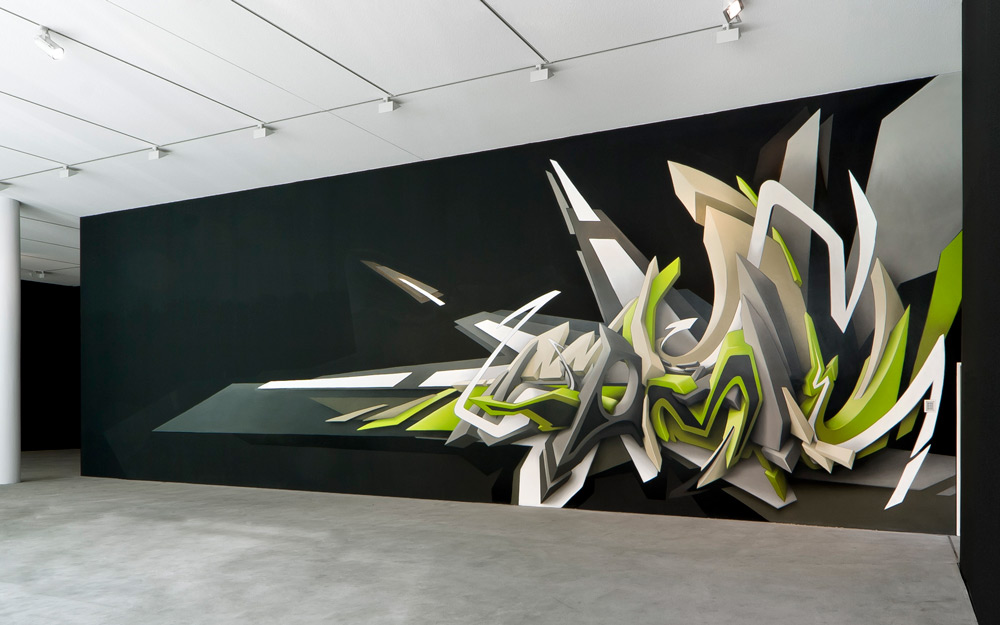
Mirko Reisser (DAIM) | “Swinging DAIM” | Spraypaint on wall | 550 x 1600 cm | 02.2007 | Exhibition: “wakin up nights” | de Pury & Luxembourg, Zurich / Switzerland | 16.02. – 16.03.2007 — Courtesy: REINKINGPROJEKTE | Photo: MRpro
Do people still think that way in the face of the fact that the art market has increasingly started to signal interest once again?
Daim: This is indeed the vital question: are you referring to people who have been producing for twenty-five years and are now also entering commercially successful fields, with works that are based on twenty-five years of experience? Or are you talking about someone in his early twenties who has just completed his graphic design studies and is drawing upon an aesthetic that will make him look good on the art market? Of course, inauthentic developments of this kind are registered and critically observed.
Weren’t you yourself someone who at the age of seventeen drew inspiration from other people’s work, such as that created by protagonists of the American scene?
Daim: Of course. To a certain degree this is common practice and constitutes a driving force of the entire Hip-Hop scene, that is, to adopt something and to make something new out of things that are already there, or to put these together in new ways. And to then, in turn, pass these on again.
However, this wasn’t done for success or money.
Exactly. And that’s the difficulty. We didn’t have the objective to earn money with our products or to create an art work or even to be artists. It was more of an adventure in testing the boundaries. I don’t want to pass judgment in any sense, but today this has completely changed. As you know, my roots lie in traditional graffiti. Nowadays people are talking about Urban Art, a rather open term that incorporates installations, performances, stencil art, right up to traditional train graffiti bombing.
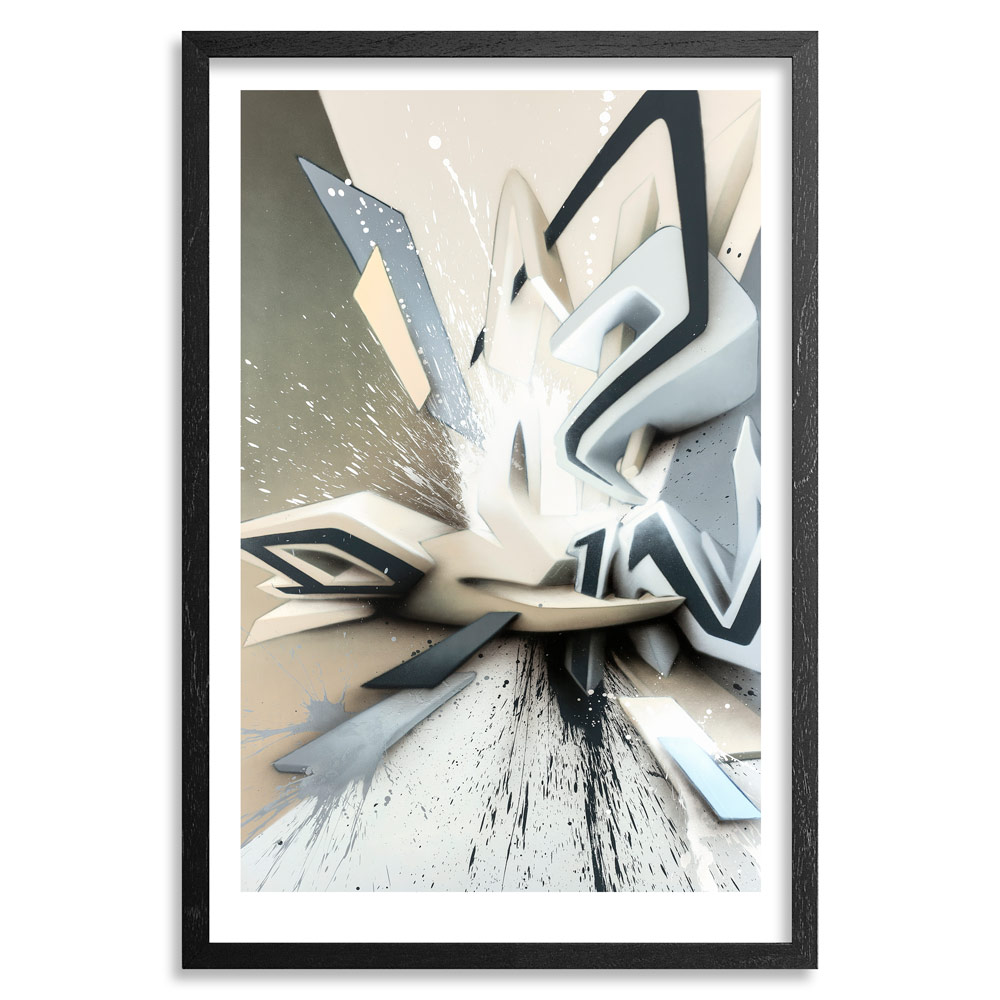
$?III by Daim – Click To Purchase
Has the art space been able to offer you anything in the past years that has led to particular works, which would not have been possible without its protective screen?
Daim: From around 2005 onward, when my collaboration with Rik Reinking began, one can clearly perceive a shift in my work. There were increasingly more participations in exhibitions and they became more important. For example, the large wall pieces at the Art Cologne, the Villa Merkel, the Kunsthalle Barmen in Wuppertal, or also my contribution to the program accompanying the Biennale in Venice. My works changed in a manner that would not have been possible in the context of the street. Yet I worked almost exclusively in museums and less in gallery spaces where the sales aspect is dominant. I still perceive the museum space as a public space. And I keep trying to conquer this space with its very distinctive requirements in new ways over and over again. Of course, the works in a museum are already transformed through entirely banal circumstances: One has time. There’s light and warmth. It can’t rain. Those are simply optimal conditions.
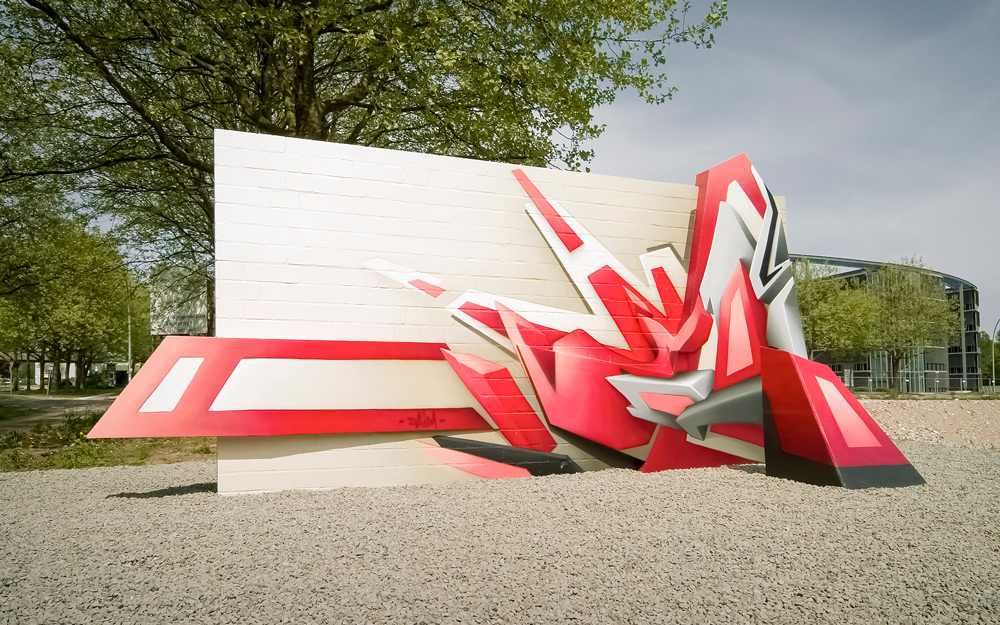
Mirko Reisser (DAIM) | “Die Mauersprengung” | Sculpture | 240 x 500 x 200 cm | 2006 | Exhibition: “sculpture@CityNord” | Hamburg / Germany – – Courtesy: sculpture@CityNord | Photo: MRpro
There are also people from the art scene who resort to the spray can to realize works in the museum space. I’m thinking concretely in this respect, for instance, of Katharina Grosse. Does her work interest you?
Daim: Already in 1965, Martin Barre resorted to the spray can, and Gordon Matta-Clark also worked with graffiti elements at a very early stage. In current painting, one might name artists such as Till Gerhard or Tom Früchtl, who either work with the spray mist as an aesthetic element or apply graffiti very precisely to the canvas with the brush. Katharina Grosse works with a compressor and not with a can, which is technically a major difference. Her approach is also entirely different with regard to historical roots. I can’t really link her color field works to graffiti at all. Even if she states in interviews that she has been inspired by the graffiti scene. I like her uncompromising stance, for instance in those cases where her work extends across an entire room. This is also to be found, however, in the graffiti scene, when, for example, the entire interior of a train compartment is illegally covered with spray paint. In this case, it’s an act of vandalism that also has something decisively aesthetic about it.
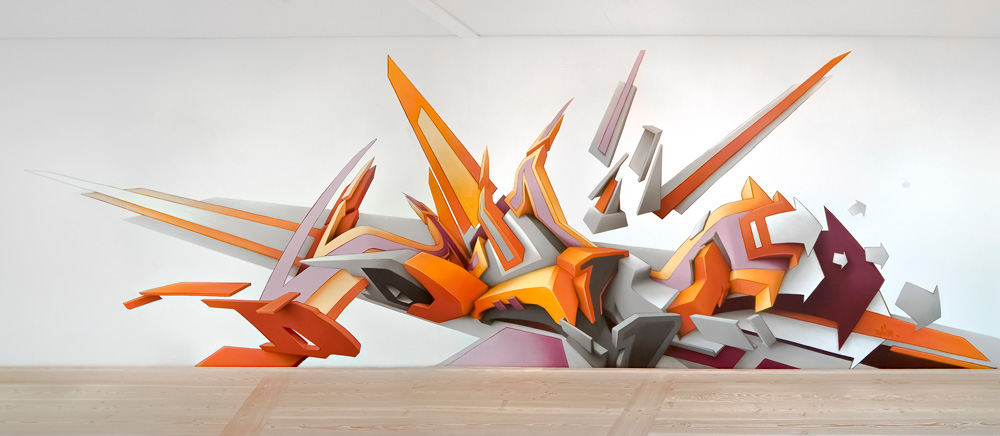
Mirko Reisser (DAIM) | “DAIM – coming out” | Spraypaint on wall | 364 x 1143 cm | 2008 | Exhibitionview: “Call it what you like! COLLECTION RIK REINKING” | Silkeborg Bad / Denmark — Courtesy: KunstCentret Silkeborg Bad / Sammlung Reinking | Photo: MRpro
Are there in fact collections and museums that collect Urban Art in the meantime?
Daim: One must say that in the past years, particularly due to the hype surrounding Banksy, a gigantic market has developed with regard to Street Art or Urban Art. Of course everyone is pouncing on that: galleries, museums, auction houses. It’s important to see that persistent artists already for years have been capturing a position in the museum space and on the art market. Above all, Barry McGee who worked the streets of San Francisco under the alias Twist and in consequence of his travels through Brazil became an important source of inspiration himself. Resultantly, Os Gemeos were able to develop their very unique style and today are successful worldwide. Blek le Rat laid the foundations for many stencil artists, including Banksy, among others.
But also other positions of Urban Art, such as those of JR, Blu, Shepard Fairey, Daniel Man, Brad Downey, Boxi, or Evol, to name only a few, have established themselves in the collections and exhibitions all over the world. Yet, next to the successful marketing of the art works, the exchange and mutual vitalization of the scene is the much more decisive factor for me.
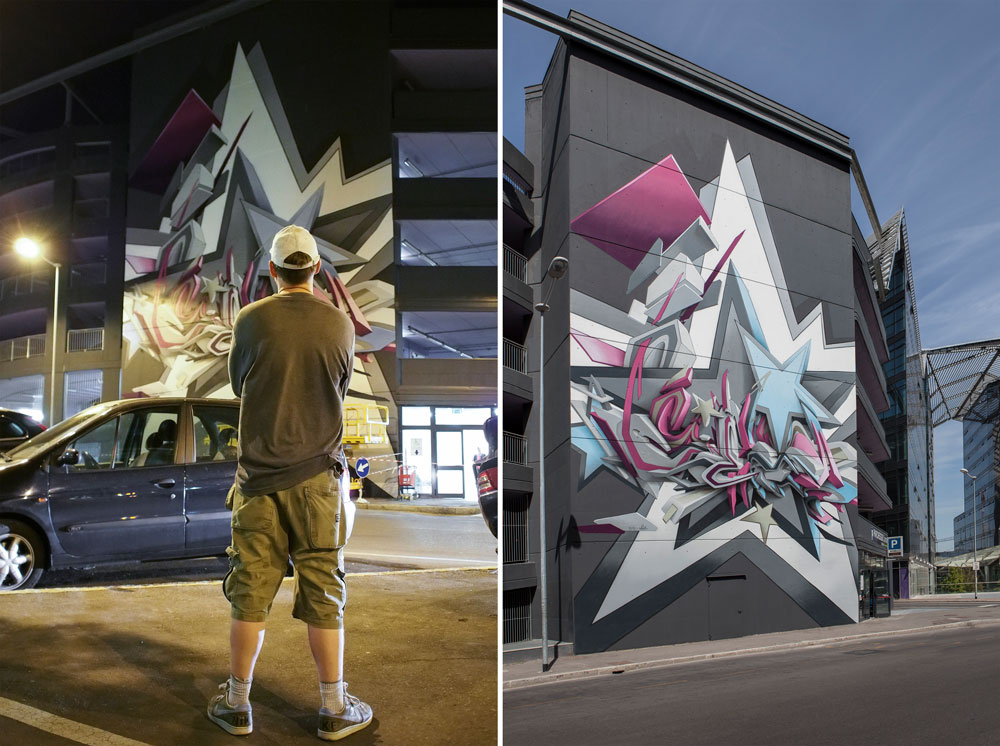
Mirko Reisser (DAIM) | “DEIM – corner to corner” | 20 x 12 m | Bologna, Italy | 2012 | For “Frontier – the line of style” / Associazione Culturale ALL WRITE | making of — Courtesy: Associazione Culturale ALL WRITE / Frontier | Photo: Marco Monetti Mirko Reisser (DAIM) | “DEIM – corner to corner” | 20 x 12 m | Bologna, Italy | 2012 | For “Frontier – the line of style” / Comune de Bologna and Associazione Culturale ALL WRITE. — Courtesy: Associazione Culturale ALL WRITE / Frontier | Photo: MRpro
Is traditional graffiti still in demand on the art market today?
Daim: Traditional graffiti art has the chance to slip in here and there and to be part of exhibitions and auctions. However, this is more of an exception. I see it this way: under the umbrella of Urban Art, graffiti, Street Art, and various forms ranging from sculpture up to performance are conjoined. Traditional graffiti art is not so easily accepted by people because it simply isn’t so small-dimensioned, stencil-like, and humorous, but comes across as more resistant, colorful, wild, illegible, hermetic, and aggressive. This is why only a few traditional graffiti sprayers are successful on the terrain of the art market. I have been writing my name now for twenty-five years, and my existence as a rather traditional graffiti “sprayer” can be seen as quite a big exception.
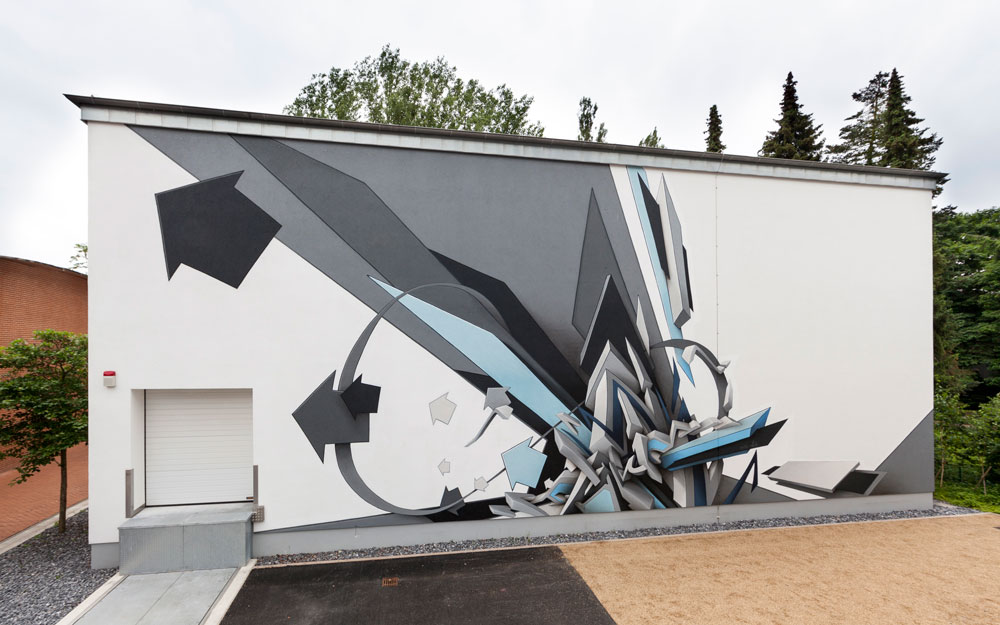
Mirko Reisser (DAIM) | “D/-\IM – up and around Marta Herford” | Spraypaint on wall | 8,8 x 21,5 m | 06.2013 | Museum Marta Herford | Herford / Germany — Courtesy: Museum Marta Herford / ReinkingProjekte | Photo: MRpro
Do you still have an eye for what is happening on the street today? Or, posing the question differently: is a development even possible in the face of the narrow stylistic margins to which writers still adhere today?
Daim: One might say that graffiti has been caught in its dogmatic manifestation for fourteen years. It’s constantly going around in circles; it’s a perpetual repetition. Yet all those people who are flying around in the carousel once in a while fling something out into the world that can establish itself as new.
Do you have any examples for this?
Daim: The evolvement of graffiti to a very widely faceted Urban Art movement is indeed the best example for the fact that this scene is simply indestructible. Almost all of the protagonists of the entire movement have their roots or sources of inspiration in graffiti. And even today graffiti still holds a strong fascination for young people. They are the driving force of the scene!
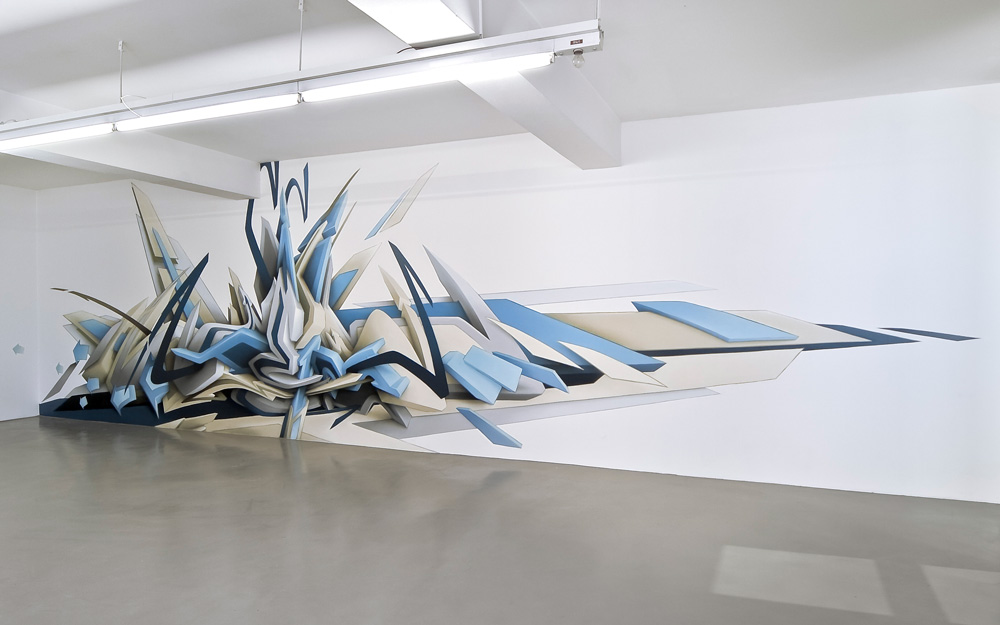
Mirko Reisser (DAIM) | “DEIM – wartend” | Spraypaint on wall | 337 x 1180 cm | 04.2009 | Exhibitionview: “Urban Art aus der Sammlung Reinking”, Weserburg, Museum für moderne Kunst, Bremen. — Courtesy: Weserburg | Museum für modern Kunst / REINKINGPROJEKTE | Photo: MRpro
You often work together collectively with other graffiti-artists. What distinguishes the work that you create alone from the work that you produce in the collective, where you have to make more compromises?
Daim: I originally come from group work. I started out spraying in a team with my crew. But working illegally in itself demands compromises: it’s dark and you have to be fast. It might be raining. You’re tired and still under age and have to get home quickly before your parents discover that you’ve sneaked out in the middle of the night. All of these are compromises. The spray can is already a compromise. It doesn’t allow you to work in an extremely delicate and precise manner. It’s empty pretty fast and expensive, and so on. Plus the group dynamics. Graffiti itself is one big compromise. The salient point is to emancipate oneself and to learn not to compromise. In my case this become more and more acute from 2005 onward, when I began to increasingly work in the realm of exhibitions. Here, all of a sudden your own unique, personal work counted and you couldn’t hide behind a team. On the other hand, it’s also nice to work together with a good team again, with colleagues, whose styles have developed in such a way that they’re compatible with one another. I’m thinking for instance of the extensive wall projects, which we work on together in our studio collective getting-up.
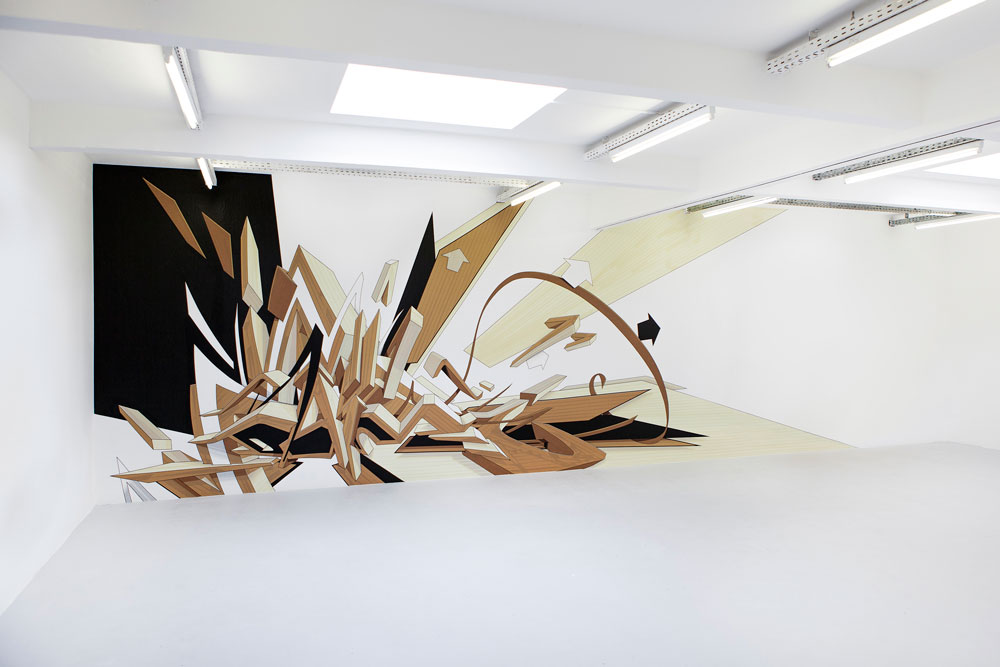
Mirko Reisser (DAIM) | “DAIM – up and around Innsbruck” | Tape on wall | 3,2 x 11,2 m | 07.2013 | “DAIM – dripping end” and “DAIM ?$ II” | spraypaint on canvases | each 230 x 140 cm | 04.2005 | Exhibitionview: “Urbane Folklore” | Kunstraum Innbruck (Austria) | 06.07. – 23.08.2013 — Courtesy: Kunstraum Innsbruck / ReinkingProjekte | Photo: MRpro
What exactly makes typical DAIM graffiti typical DAIM graffiti?
Daim: My work is tightly linked to my personality. And this is what makes it special, since I don’t exist twice as a human being.
In some of your more recent works, for instance in DAIMaround, you have entered increasingly expansive graphical spheres with your graffiti writing. Is your work currently becoming more and more graphical?
Daim: Each of my works still starts out very classically with a pencil sketch. The sketches are then further developed, refined, and perfected via the computer. Sometimes, years pass before I take the sketches up again. The increase in graphical elements in my work is connected to my increasing participation in exhibitions in the museum space. How does one conquer this space with a work, also in competition with the other works surrounding it? It is no longer merely the issue to handle an entire wall. I strive for a new, more intelligent conquest of the space that leaves my own works and those in its proximity enough air to breathe. This idea was at the basis of DAIMaround, a wall piece that I created for the exhibition ARTotale in Lüneburg.
This time, my objective was to situate my signature, which is usually located in the center, on the margin instead, placing elements into the space from this starting point, a metaphor for the beginning of my conquest of the space.

Mirko Reisser (DAIM) | “DEIM – corner to corner” | 20 x 12 m | Bologna, Italy | 2012 | For “Frontier – the line of style” / Comune de Bologna and Associazione Culturale ALL WRITE | making of — Courtesy: Associazione Culturale ALL WRITE / Frontier | Photo: Marco Monetti
The more sensitive conquest of spaces is thus a result of your collaboration with Rik Reinking, who first and foremost works in the art space?
Daim: He sensitized me for the art space through the direct discussions, yet even more so through the possibilities that he opened up for me. Thus, I had enough scope for thought and freedom to develop new works.
What actually happens when in a large-scale Urban Art project like the one realized in 2009 in Lüneburg a bunch of Urban artists from all over the world come together and work together in the public sphere of an entire city? This is actually a highly communicative act. Everybody can see it. The newspapers cover it. The scene networks on an internal level. One might even say: it was impossible for anybody in town not to perceive this project.
The graffiti and the Urban Art scene have a lot to do with advertising. It’s very annoying that the public space is so strongly dominated by commercial interests. All unblocked views are bought up and crammed with advertising. Graffiti also attempts to counter this, in fact with similar means.
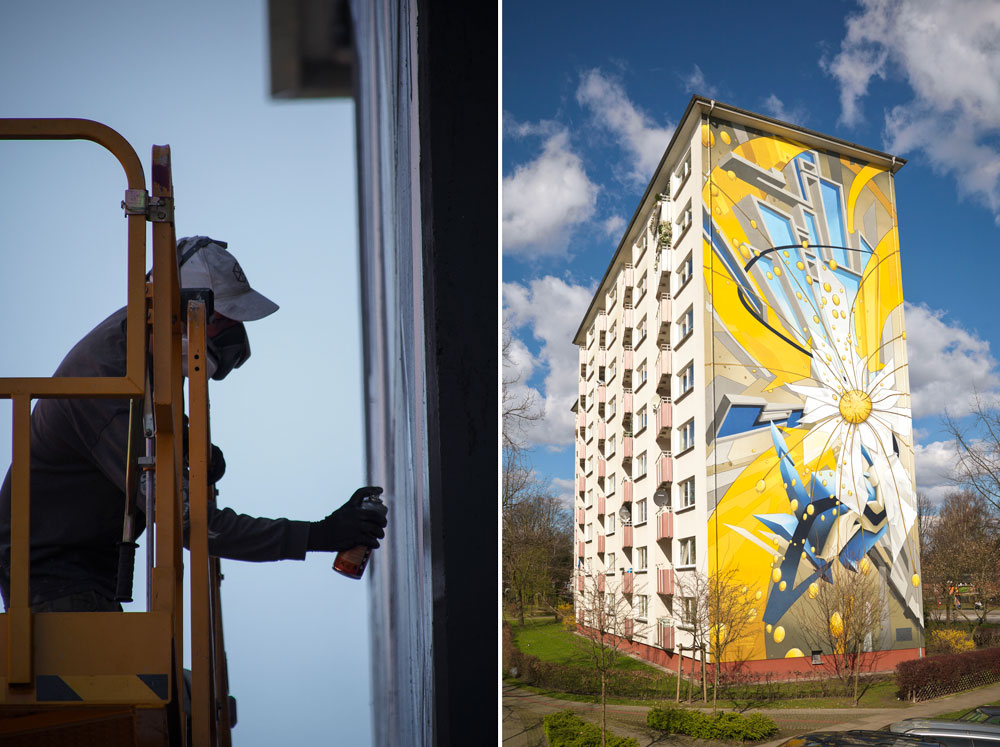
Mirko Reisser (DAIM) | “DEIM – corner to corner” | 20 x 12 m | Bologna, Italy | 2012 | For “Frontier – the line of style” / Associazione Culturale ALL WRITE | making of — Courtesy: Associazione Culturale ALL WRITE / Frontier | Photo: Marco Monetti DAIM, Tasek, RKT One | “Identität” | 25 x 10,7 m | getting-up project | Hamburg-Rothenburgsort / Germany | 2007 / 2008 — Courtesy: getting-up | Photo: Gulliver Theis
Are there critics who then say: damn, do we need all that colorful Urban Art taking up space in our cities, which are already teeming with information? Is it no longer possible to have a sober view of the city?
Daim: I can indeed imagine a world without advertising and without Urban Art. But a world with only advertising and no Urban Art? That’s a terrible notion!
In the meantime, Urban Art is also a global frame of reference for millions of people.
Absolutely. In any case for those who are active in the scene. And, of course, the scene draws its existence from the fact that there are many active artists. This continues to induce interaction.
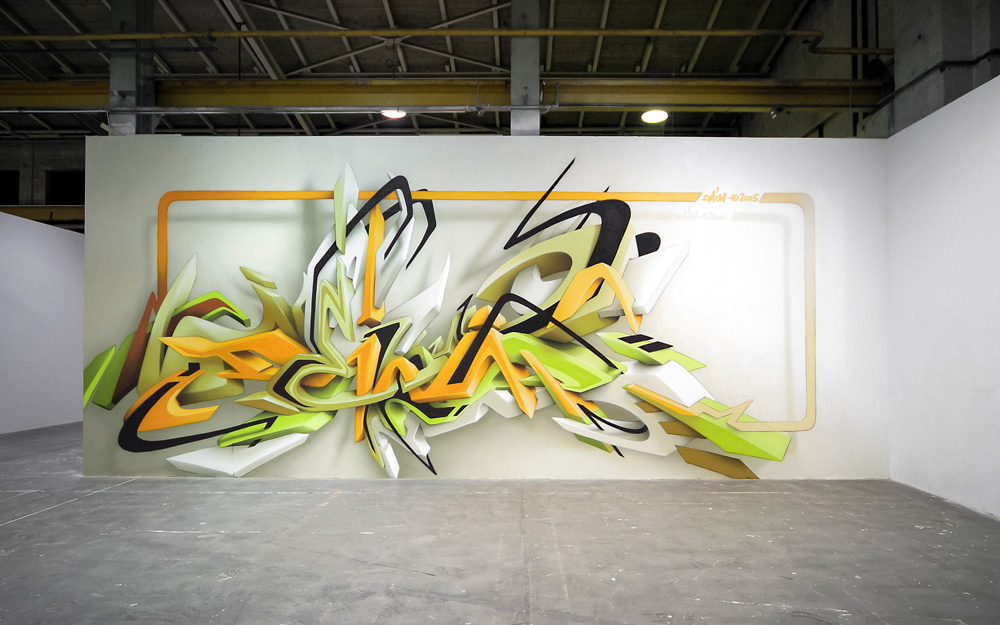
Mirko Reisser (DAIM) | “DEIM – auf der Lauer” | 400 x 950 cm | spraypaint on wall. Kampnagel halle K3, Hamburg / Germany | 04.2005 — Courtesy: REINKINGPROJEKTE | Photo: MRpro
How do you perceive your career in retrospective?
Daim: I do not believe that there is an exact point for making the right decisions in life, but rather a certain time span for doing so. Sometimes this covers weeks, sometimes years. It is only important to make the right decision in the right time span. I always managed to get into the right time span with my works, but sometimes the comprehension, internalization, and execution of ideas took me a long time. But at least I did comprehend, internalize, and realize them. If this is the case, you don’t need to look back with regret. And of course in retrospective that’s a good thing. For countless years I attended jams of one kind or another every summer: in Germany, in Europe, all around the world. This way, I got to know many countries and cities. I met lots of people and collaborated with them. Naturally, this was a great experience. And I could have probably given that up many years earlier. But I pushed on with it up to the point where I realized: the subject is exhausted.
Are you saying that you always have to exhaust a subject entirely before you can take the next step?
Daim: Of course this is not a strategy for shooting stars who immediately run the whole gamut. But ultimately that’s also a question of personality.
Are the tapings that you are currently producing the next step in your work?
Daim: A few years ago, I discovered tape, that is, plain old adhesive tape for paper as a material for my work. Already in 2006, I realized my first works in this technique. But lately I have been focusing more and more on this medium of expression. For me, tape is the ideal connection between the digital vector graphics that I work with and the manual kind of work, which I am familiar with from employing the spray can. I can thus remain true to my previous work, while still setting out into a completely new field of action.
Where else can people find you?
Daim: Website – Facebook – Twitter @DAIMorg
– Interview by Arne Rautenberg
